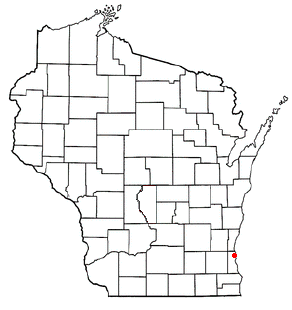Whitefish Bay National Guard Armory facts for kids
Quick facts for kids |
|
|
Whitefish Bay National Guard Armory
|
|
 |
|
| Location | 1225 E. Henry Clay St. Whitefish Bay, Wisconsin |
|---|---|
| Architect | Herbert Tullgren |
| NRHP reference No. | 02000650 |
| Added to NRHP | June 6, 2002 |
The Whitefish Bay National Guard Armory was a special building in Whitefish Bay, Wisconsin. It was located at 1225 East Henry Clay Street. This armory was a large red brick building. It had a unique top that looked like castle walls (called "crenelated"). There was also a tall central tower. People even called it "the finest armory in the state"!
Inside, the armory had many rooms. There were bright classrooms and wide hallways with shiny floors (called terrazzo). A grand double staircase led upstairs. It had a fancy, pointed arch window (called an ogee window). The building also featured a gym, a kitchen, and a comfy lounge. The lounge had a cool beamed ceiling and a huge fireplace. The armory was built in 1928. It was designed by a well-known local architect named Herbert W. Tullgren.
Contents
History of the Land
The land where the armory stood was once part of a bigger property. In 1870, a German immigrant named Friedrick Gustave Rabe bought 19 acres of land. He built a white farmhouse there for his family. His land was bordered by several streets: Henry Clay Street, Ardmore Avenue, Fairmount Avenue, Marlborough Drive, and Kimbark Place.
After Mr. Rabe passed away, the property was bought by Otto Falk. He was an important person at a company called Falk Corporation. He was also a high-ranking officer in the Wisconsin National Guard.
A Training Ground
Around 1909, the property started being used as a summer camp. It was for a National Guard artillery unit. The old farmhouse became home to three different commanding officers and their families.
Many different Wisconsin National Guard units trained on this land. They prepared for important duties in several wars. These included the Mexican border war, World War I, World War II, and the Korean Conflict. The armory became the home base for the United States Army’s 32nd Infantry Division. This division was known as the "Red Arrow Division." Their shoulder patch, which looks like a red arrow, is now a key part of the memorial garden at the site. It shows how tough they were in battle.
Building the Community
In 1927, 13 acres of the land were sold to the village. This part of the land was used to build Whitefish Bay High School. The high school opened its doors in 1932. The same architect who designed the armory, Herbert Tullgren, also designed the high school. He also designed the village hall and several elementary schools in the area. These schools included Cumberland, Richards, and Henry Clay (which is now Whitefish Bay Middle School).
In 1941, more buildings were added to the armory site. Red brick garages were built on the west side. The old farmhouse also got a two-story addition. This new part had offices, classrooms, and a special club room for officers. This club room had pine-paneled walls and was lovingly called "the white house."
A Place for Everyone
The armory was not just for military training. It was also a very important place for the community. Many big village events were held there, like weddings and proms. For many years, 16-year-old residents of Whitefish Bay took their driver’s license exams in one of its classrooms. In 1989, the armory was recognized as a Milwaukee County Landmark. This meant it was an important historical site.
The Armory Today
In 1995, the village of Whitefish Bay bought the armory property. People held meetings to decide what should happen to the building. Many ideas were suggested. However, in 1998, the decision was made to tear down the armory, the garages, and the farmhouse. The plan was to turn the land into a park.
There were efforts to save the farmhouse. It was one of the oldest buildings in the village. But it was torn down in 2000. The main armory building and its garages were demolished in 2004.
Today, the site is known as Armory Park. It is home to the Whitefish Bay Veterans Monument and Memorial Garden. This park honors the brave people who served in the military.

